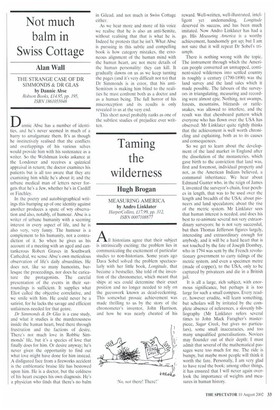Taming the wilderness
Hugh Brogan
MEASURING AMERICA by Andra Linklater HarperCollins, £17.99, pp. 312, ISBN 0007108877 All historians agree that their subject is intrinsically exciting; the problem lies in communicating the excitement of particular studies to non-historians. Some years ago Dava Sobel solved the problem spectacularly with her little book, Longitude, that became a bestseller. She told of the invention of the chronometer, which meant that ships at sea could determine their exact position and no longer needed to rely on the guesswork known as dead-reckoning. This somewhat prosaic achievement was made thrilling to us by the story of the chronometer's inventor, John Harrison, and how he was nearly cheated of his
reward. Well-written, well-illustrated, intelligent yet undemanding, Longitude deserved its success, and has been much imitated. Now Andro Linklater has had a go. His Measuring America is a worthy achievement, handsomely got up; but I am not sure that it will repeat Dr Sobel's triumph.
There is nothing wrong with the topic. The instrument through which the American people converted an unmapped, continent-sized wilderness into settled country in roughly a century (1790-1890) was the land survey and the land sales which it made possible. The labours of the surveyors in triangulating, measuring and recording were almost epic. Nothing, not swamps, forests, mountains, blizzards or rattlesnakes, was allowed to interfere, and the result was that chessboard pattern which everyone who has flown over the USA has observed. Mr Linklater quite rightly thinks that the achievement is well worth chronicling and explaining, both as to its causes and consequences.
So we get to learn about the development of the land market in England after the dissolution of the monasteries, which gave birth to the conviction that land was, first and foremost, individual property and not, as the American Indians believed, a communal inheritance. We hear about Edmund Gunter who, in the reign of James I, invented the surveyor's chain, four perches in length, that was to be used over the length and breadth of the USA; about pioneers and land speculators; about the rise of the metric system. Mr Linklater sees that human interest is needed, and does his best to re-animate several not very extraordinary surveyors; he is not very successful, but then Thomas Jefferson figures largely, interesting and extraordinary enough for anybody, and it will be a hard heart that is not touched by the fate of Joseph Dombey, who in 1794 was sent by the French revolutionary government to carry tidings of the metric system, and even a specimen metre (made of copper), to the USA, only to be captured by privateers and die in a British jail.
It is all a large, rich subject, with enormous significance, but perhaps it is too large for such a small compass. Every reader, however erudite, will learn something, but scholars will by irritated by the complete absence of references, a slovenly bibliography (Mr Linklater refers several times to John Mack Faragher's masterpiece, Sugar Creek, but gives no particulars), some small inaccuracies, and too many unqualified generalisations. Novices may flounder out of their depth: I must admit that several of the mathematical passages were too much for me. The ride is bumpy, but maybe most people will think it worth the fare. Personally, I am very glad to have read the book; among other things, it has ensured that I will never again overlook the importance of weights and measures in human history.


























































 Previous page
Previous page